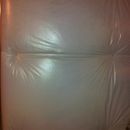Above-ground poured concrete interior insulation?
Hello all
We are planning to finish a portion of our basement. A few of the walls in the planned finished portion will be against the poured cement basement walls. The basement walls are 99+% above grade/ground. The house is a few years old located in the 4A region, close to the 5A region border in PA.
Currently there is insulation on the basement walls. It is fiberglass that is secured with a white wrap which is nailed directly into the cement walls. The white wrap appears to have a diamond pattern on it with tiny little pin holes. Pictures included.
The exterior side of the poured cement basement walls have no insulation or covering on their surface. The exterior walls are completely sheltered from sun and precipitation as there is a “waterproofed” deck which shields them as well as the walls facing due south.
The plan is to frame the walls with 2x4s close to the white wrap and place roxul insulation between the 2x4s for added R value and flanking sound isolation.
I have read many of the studies referenced and comments here, but have not been able to find a definitive answer as to whether the current insulation will be a problem. The walls will be able to dry to the outside since they are fully exposed. Is XPS still the way to go for above ground/grade walls? I do not want to waste all the current insulation and spend money if I do not need to …
Regards
Justin
GBA Detail Library
A collection of one thousand construction details organized by climate and house part











Replies
Justin,
You call this area a "basement," but you also say that the wall in question is "99% above grade." I assume that you mean that other walls are below-grade? In other words, I assume that your home is on a hill -- and that the uphill walls are mostly below grade, while the downhill wall is mostly above grade?
If the entire story is "99% above grade," I'm not sure why you call it a "basement."
If this basement is as I imagine (the basement of a house on a sloping site), you need to make sure that your insulation is continuous. You can't just insulate one wall of a basement -- you have to insulate all of your walls, because concrete is a good conductor. If you just insulate one wall, the heat will go around the insulation.
The problem with concrete walls is that they get cold in winter. When warm interior air contacts the cold concrete, condensation can result. The type of insulation shown in the photo is air-permeable. Since this isn't an airtight insulation, interior air can contact the cold concrete and lead to puddles.
If you keep your interior relative humidity on the low side, you may never have problems with this type of insulation. But if the indoor humidity rises, you can end up with condensation and puddles.
The best way to proceed is to insulate these concrete walls on the interior with some type of foam insulation (rigid foam or spray foam), or on the exterior with foam or mineral wool insulation. For more information, see How to Insulate a Basement Wall.
Thanks for the response Dan. To confirm, this is a basement and the wall in question is essentially fully above grade (there might be an inch or two below ground). This basement wall is the back of the house. The basement wall at the front of the house is about 15% above grade, and the basement side walls of the house are about 50% above grade (on a diagonal). The basement is a full walkout across the entire back with 60"x70" windows on the sides of the basement, sliding doors on the back wall, along with more 35"x60" windows on the back wall.
I will only be making 1 finished room in the basement which will comprise of about 35-40% of the overall space in the basement. The finished room in the basement will be a rectangle. Three of the walls will be 10-15 feet away from any other basement wall. One wall of the finished space will be up against the back basement wall of the house (no windows or sliding door with intersect with this finished wall).
Currently, the basement walls are completely covered in the fiberglass and white plastic wrap. I was hoping to find out if I should remove the fiberglass and wrap where the new finished wall will go. I would replace the fiberglass and wrap with xps, put the framed wall up with roxul insulation, and leave the fiberglass with wrap in the remainder of the basement.
Most of the articles I have found refer to mostly underground/below grade basement walls. In my situation, I will not be finishing any space with underground/below grade walls. The current fiberglass with wrap has not had any issues in the past few years in the basement. I was unsure if issues would arise once a finished wall was placed next to it and the space was conditioned with heat in the winter. The plan is to fully insulate the finished space on the ceiling and side walls.
I guess the answer is that I will most likely not have any issues, but the best practice would be to use xps or eps and remove the current fiberglass with wrap wherever a finished wall will be placed. I am not concerned about the rest of the basement fiberglass and wrap as if there are issues in the future, I could easily rectify them since the fiberglass and wrap will be easily accessible due to the fact that it would not be behind a 2x4 wall.